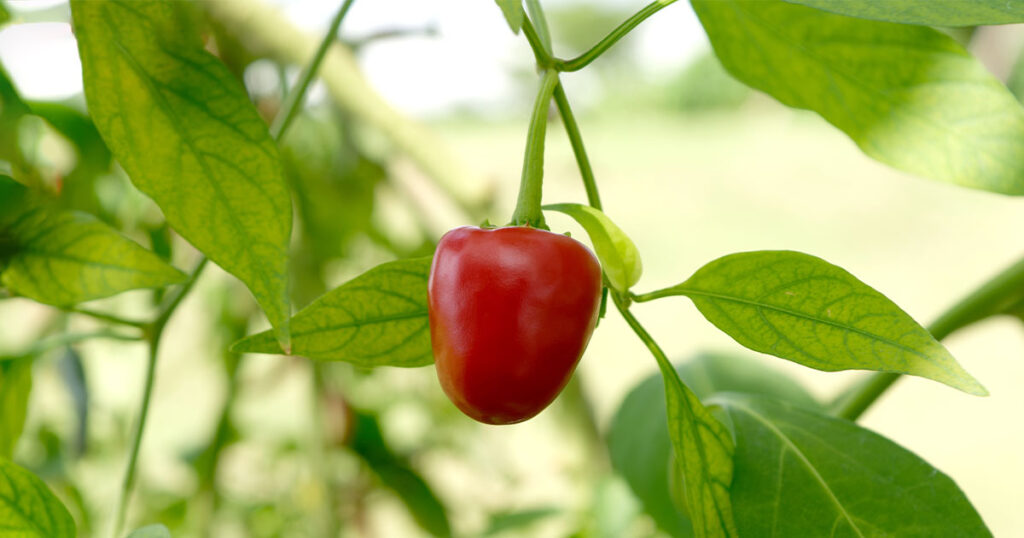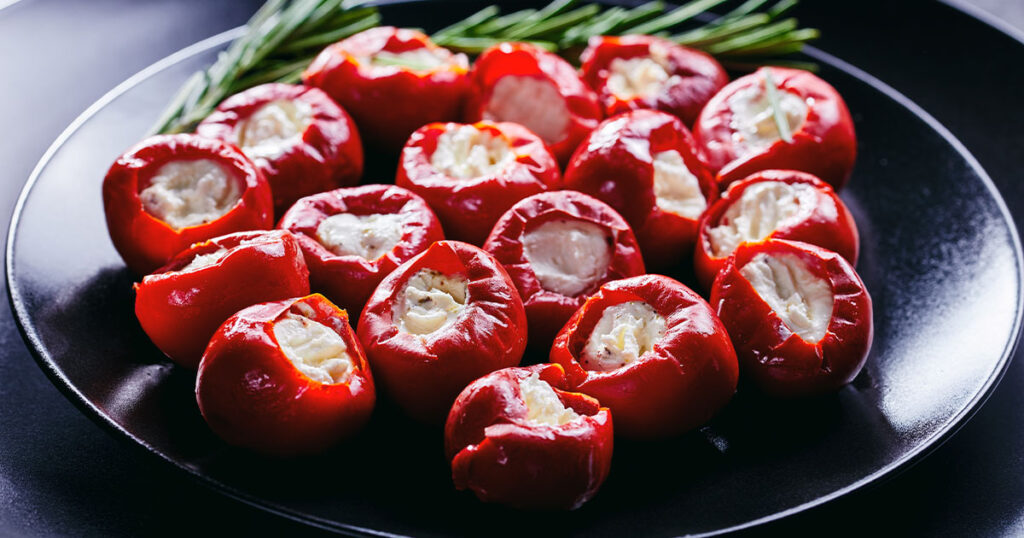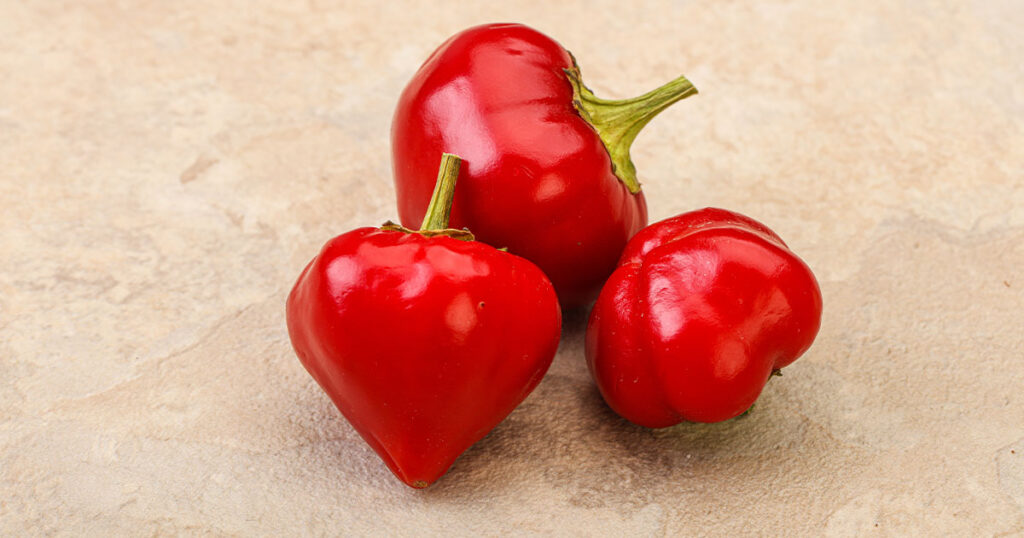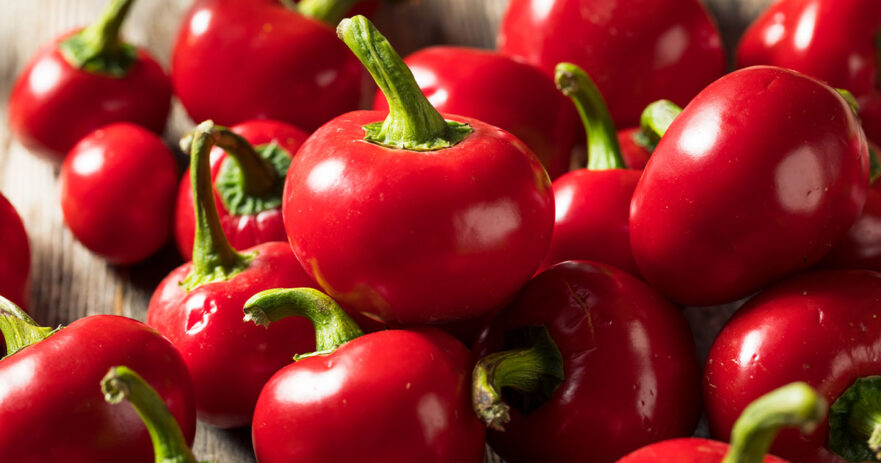In this article about cherry pepper:
🗺️ Origin and history | 🌶️ Uses | ✨ Appearance and taste | 🧑🌾 Growing – gardening | 👨🍳 Cooking – recipes | 🛒 Where to buy | 🫙 How to store | 👨⚕️ Health benefits | 🌶️ Alternatives and substitutes | ❓ Frequently asked questions
What is Cherry pepper?
The Cherry Pepper, known for its vibrant red color and round shape resembling a cherry, is a unique balance of sweetness and spiciness. These peppers are categorized as mild to medium in spiciness, boasting a Scoville heat rating between 2,500 and 5,000 SHU, underscoring their culinary versatility. Cherry Peppers are celebrated for their juicy and crisp texture, adding color and flavor to any dish. They are particularly popular in pickled forms, stuffed with cheeses or meats, and used in salads, sandwiches, and pizza toppings. Gardeners and chefs cherish Cherry peppers for their aesthetic appeal and the bright, bold flavors they bring to the table, making them a versatile addition to various recipes.
Are Cherry peppers spicy? How hot are they?
Cherry peppers scoville: 2,500 to 5,000 SHU
The Cherry pepper, with its Scoville heat rating ranging from 2,500 to 5,000 SHU, positions itself as a mild to medium pepper on the heat spectrum. This range is notably lower than many hot peppers, providing a gentle warmth that complements its sweet profile rather than overwhelming it. For comparison, the well-known jalapeño pepper typically falls between 2,500 and 8,000 SHU, placing Cherry peppers on the milder side of the scale.
Even within the sweet peppers category, the heat level of cherry peppers offers a unique blend, bridging the gap between the non-spicy bell pepper and the fiery varieties. This mild spiciness allows them to enhance dishes with a touch of heat without dominating the overall flavor palette. They are a favorite among those who appreciate a subtle kick in their culinary creations, making them a versatile ingredient in kitchens worldwide.
🗺️ ORIGIN AND HISTORY
Where does the Cherry pepper come from?
Cherry peppers, botanically classified as Capsicum annuum, trace their roots back to the regions of Mexico, South America, and Central America, where they have been cultivated since ancient times. These peppers are known for their small, uniform pods that resemble cherries and cherry tomatoes in size and shape, hence their name. They are also referred to as Hungarian Cherry Pepper, Cherry Bomb Pepper, and Sweet Cherry Chile Pepper due to their round to slightly ovate shape and the bright, sweet-tart flavor they possess.
The journey of Cherry peppers from their native tropical climates to European gardens and eventually to global recognition began with their introduction to Europe and Asia by Spanish and Portuguese explorers during the 15th and 16th centuries. Their unique shape and flavor quickly made them a favorite, leading to the development of various cultivars to meet changing market demands.
🌶️ USES
What are Cherry peppers good for? How to use them?
Cherry Peppers, known for their vibrant red color and balance of sweetness and spiciness, are a culinary delight offering various uses across various cuisines. Their juicy and crisp texture and mild to medium heat make them a versatile ingredient in fresh and cooked dishes.
Pickled sweet cherry peppers are a kitchen staple, praised for their capability to enhance flavors and add a zesty kick to dishes. These pickled delights serve perfect toppings for sandwiches, salads, and pizzas, infusing meals with bright flavor and color. Their thick flesh is ideal for pickling, soaking the brine well, and maintaining a crisp texture. Pickled cherry peppers in a jar offer convenience and enhanced sweet-tart flavor, making them a delectable addition to an extensive range of recipes. Whether served whole as a garnish, sliced into appetizers, or blended into main dishes, they add an extra layer of flavor, cherished for their bright, sweet-tart taste and gentle heat.
For those interested in canning cherry peppers, this method allows you to preserve the harvest’s bounty, ensuring you can enjoy the bold flavors of these peppers year-round. Whether you choose to pickle them for a tangy snack or can them for later use, canned cherry peppers offer a taste of summer any time of the year.
In addition to pickling, cherry peppers can be stuffed with various fillings, such as cheeses, meats, or a mixture of vegetables, and then baked or grilled to perfection. This transforms them into a bold and flavorful appetizer or side dish that will impress. Their mild heat and sweetness make them a great ingredient for sauces, dips, and spreads, adding a unique flavor profile to any culinary creation.
Whether pickled, stuffed, or used fresh, Cherry peppers are an excellent way to add color, texture, and a flavorful kick to your dishes. Their versatility and bold flavors make them a beloved ingredient among chefs and home cooks alike, elevating the taste and presentation of numerous dishes with their distinctive charm.
✨ APPEARANCE AND TASTE
What does a Cherry pepper look like?
Cherry peppers are small, round chili peppers that boast a vibrant red flesh, making them visually striking and easily recognizable. They are known for their compact size, approximately 1.5-2 inches in diameter, resembling the shape and color of cherries, hence their name. Initially green, these peppers transition to a bright red as they mature, adding a pop of color to gardens and dishes.
What does Cherry pepper taste like?
Cherry peppers offer a delightful balance of sweetness and heat, providing a fresh and lightly sweet flavor with a spicy kick. Their heat level is mild to medium, similar to or slightly less spicy than jalapeños. This unique combination of sweetness with a touch of spiciness makes Cherry peppers versatile in culinary applications. While they share some similarities with pimientos in appearance, Cherry peppers are distinguished by their flavor, which stands out with their perfect blend of sweetness and heat.
Whether served fresh, pickled, or cooked, Cherry peppers are a versatile ingredient that can enhance various dishes with their unique taste and vibrant appearance.
🧑🌾 GROWING – GARDENING

How to grow Cherry peppers?
Growing Cherry peppers requires full sun, well-drained soil enriched with organic matter, and regular watering to ensure the soil remains moist. Plant them after the last spring frost when the weather has warmed, spacing them 18 to 24 inches apart. Using a continuous-release fertilizer and mulching around the plants can enhance growth and fruit production.
When to pick Cherry peppers?
Cherry peppers are typically ready to pick about 80 days after planting. They can be harvested when they turn green, indicating they have reached maturity, or allowed to ripen on the plant to a red color for a sweeter taste. Harvesting early can encourage the plant to bloom and produce more fruit, although this might affect the taste if used fresh. Use shears or a knife to cut the peppers from the plant to avoid damaging it.
👨🍳 COOKING – RECIPES
Cooking / Recipe ideas for Cherry peppers
Cherry peppers, known for their vibrant blend of sweetness and spiciness, are a versatile ingredient that can elevate many dishes. One of the most popular ways to enjoy cherry peppers is by stuffing them, which allows their flavor to be complemented by various fillings.
A classic recipe involves stuffing Cherry peppers with a rich and flavorful filling. One approach is to mix cooked Italian sausage with softened cream cheese, breadcrumbs, grated parmesan cheese, minced scallions, parsley, garlic, a dash of salt and pepper, and an egg to bind it all together. After halving the Cherry peppers and removing the seeds, they are filled with this savory mixture and baked until the filling is golden brown and bubbling. This method creates a delightful appetizer that combines the tangy sweetness of the peppers with the creamy, herby filling.
For an Italian twist, Cherry peppers are often stuffed with prosciutto and provolone cheese. The process involves wrapping cubes of provolone in squares of prosciutto, which are then nestled into the cavities of the peppers. The stuffed peppers can be marinated in a mixture of olive oil, pepper brine, parsley, and oregano to infuse them with additional flavors before serving. This variant is not only a testament to the traditional Italian antipasto but also showcases the cherry peppers’ ability to pair beautifully with the prosciutto’s saltiness and the provolone cheese’s smoothness.
Another simple yet delicious recipe calls for filling Cherry peppers with a blend of ricotta and cream cheese flavored with garlic powder, onion powder, salt, and finely chopped parsley. This mixture is spooned into jarred Cherry peppers drained of their brine. The result is a quick and easy appetizer that features the creaminess of the cheese filling against the slight bite of the pickled peppers, making for a perfect balance of flavors.
Pickling Cherry peppers is another fantastic way to enjoy their unique balance of sweetness and heat. This process not only extends the shelf life of these vibrant peppers but also enhances their flavor, making them a tangy addition to many dishes. Pickled Cherry peppers can be easily prepared at home with a simple brine of vinegar, water, salt, and sugar, along with optional spices to taste. Once jarred and allowed to marinate, these peppers develop a delightful depth of flavor that complements salads, sandwiches, and charcuterie boards or can be enjoyed straight from the jar as a zesty snack. The beauty of pickling lies in the ability to adjust the seasoning to personal preference, ensuring each batch of pickled Cherry peppers is perfectly suited to your taste. Whether incorporated into recipes or served as a standalone treat, pickled Cherry peppers offer a delightful burst of flavor that captures the essence of the pepper in every bite.

🛒 WHERE TO BUY
Where can I buy Cherry peppers?
For purchasing Cherry peppers, they are typically available at larger supermarkets or specialty stores, particularly during their peak season from August to September. Outside of this season, they can also be found pickled or stuffed in jars in most grocery stores. Online platforms and specialty food websites offer a wide selection of Cherry peppers year-round, catering to those who prefer the convenience of online shopping.
Where can I buy Cherry pepper plants?
When looking to buy Cherry pepper plants, local garden centers or nurseries are good places to start, as they often carry a variety of pepper plants, including Cherry peppers, during the planting season. For a wider selection, online gardening stores and seed catalogs offer Cherry pepper plants with the convenience of home delivery, allowing gardeners to access a wider variety of plants.
Where can I buy Cherry pepper seeds?
Cherry pepper seeds can be purchased from local garden centers or online seed suppliers, offering a range of Cherry pepper varieties for home gardening. Online stores provide an extensive selection and often include detailed planting and care instructions to ensure successful growth. For gardeners interested in starting their Cherry peppers from seeds, these resources can be invaluable for finding specific varieties and obtaining quality seeds.
🫙 HOW TO STORE
How do I store Cherry pepper?
Storing Cherry peppers effectively involves keeping them in a cool, dry place for short-term use or refrigerating them in a plastic bag or airtight container to prolong their freshness. This method is ideal for maintaining the quality of the peppers for a few weeks. Ensure that the peppers are dry before storing them to prevent mold growth. For those looking to keep their Cherry peppers for longer, consider pickling them, which not only extends their shelf life but also adds a flavorful dimension to their use in cooking.
Can Cherry peppers be frozen?
Yes, Cherry peppers can be frozen. To freeze, wash, and thoroughly dry the peppers, remove stems and seeds if preferred, and place them on a baking sheet in the freezer. Once frozen, transfer the peppers to a freezer-safe bag or container. This method preserves their flavor and texture for several months, making it a convenient option for enjoying Cherry peppers throughout the year.
❤️🩹 HEALTH BENEFITS

Are Cherry peppers healthy?
Like many chili peppers, Cherry peppers are not only flavorful but also offer a range of health benefits. They are low in calories and a good source of vitamins A and C, important for maintaining good health, supporting the immune system, and providing antioxidant properties.
The capsaicin content in Cherry peppers can help boost metabolism, which may aid in weight loss. Furthermore, capsaicin has been linked to reducing inflammation and pain. Including Cherry peppers in your diet can add nutritional value and enhance the taste of your meals.
🔄 ALTERNATIVES AND SUBSTITUTES
What’s a suitable alternative to Cherry pepper?
When seeking alternatives to Cherry peppers, it’s essential to balance both the flavor profile and heat level to match the unique combination Cherry peppers offer. With their sweet taste and very mild heat, Pimiento peppers are an excellent substitute, especially in dishes with a softer flavor without spiciness.
Peppadew peppers, on the other hand, provide a sweet and slightly spicy taste that can enhance salads, pizzas, and even stuffed recipes, mirroring the versatility of Cherry peppers.
Jalapeño peppers introduce a spicier edge, making them suitable for those who wish to add more heat to their dishes while enjoying a rich flavor. They work well in salsas, marinades, and as toppings. Banana peppers offer a different approach with mild heat and a sweet flavor. They are perfect for sandwiches, salads, and pickling, similar to Cherry peppers but with a distinct taste. Serrano peppers, offering a sharper heat, are ideal for cooked dishes where their spiciness can be balanced out by other ingredients, providing a depth of flavor that complements the dish without overwhelming it.
Each of these substitutes brings its unique characteristics to the table, allowing for a range of culinary applications that can adapt to the absence of Cherry peppers, ensuring that the dish’s essence remains intact while introducing new flavors and textures.
How do you pronounce Cherry peppers?
The pronunciation for Cherry peppers is “CHAIR-ee PEP-erz”.
🙋 FREQUENTLY ASKED QUESTIONS
FAQ about cherry peppers
Are Cherry peppers hot?
Cherry peppers are characterized by their mild to medium spiciness, quantified by a Scoville heat rating ranging from 2,500 to 5,000 SHU. This relatively low heat level situates them on the milder end of the chili spectrum, particularly in comparison to hotter varieties such as jalapeños, whose heat can extend from 2,500 up to 8,000 SHU. This makes Cherry peppers a versatile choice for those who appreciate a hint of heat without overwhelming spiciness, suitable for various culinary applications.
Is a Cherry pepper a jalapeño?
No, a Cherry pepper is not a jalapeño. Cherry peppers and jalapeños are distinct chili peppers with unique characteristics and heat levels. Cherry peppers are known for their round shape and vibrant red color, resembling a cherry, and typically have mild to medium spiciness. In contrast, jalapeños are generally more elongated and green when unripe, offering a heat level ranging from mild to hot, making them distinctly different in appearance and taste profile.
How hot is Cherry Bomb pepper?
The Cherry Bomb pepper is another name for cherry pepper, and it offers a medium heat level, with its Scoville Heat Unit (SHU) rating typically falling between 2,500 and 5,000. This places it in the mild to medium spiciness category, making it suitable for those who appreciate a noticeable but not overwhelming heat in their dishes. Its balanced heat complements its natural sweetness, making it a versatile ingredient in culinary applications.
What are other names for Cherry peppers?
Cherry peppers are known by various names that reflect their culinary versatility and regional popularity. These include Hungarian Cherry Pepper, Cherry Bomb Pepper, and Sweet Cherry Chile Pepper. Each name highlights a different aspect of the pepper's identity, from its appearance to its taste profile, indicating the wide range of uses and the broad appeal of this mild to moderately spicy pepper across different cuisines and cultural contexts.
Can you eat Cherry peppers raw?
Cherry peppers can be eaten raw, offering a delightful combination of a crisp texture and a balanced taste profile that merges sweetness with a gentle spicy kick. This makes them an incredibly versatile ingredient, perfect for incorporating into salads and sandwiches and as a vibrant, fresh garnish. Their unique flavor and texture add a distinctive touch to various dishes, enhancing the overall sensory experience of meals with their mild yet flavorful spice and appealing crunch.
Is a cherry pepper a chili pepper?
Yes, cherry peppers are a type of chili pepper, categorized under Capsicum annuum, which includes a wide range of peppers from the sweet bell to the fiery habanero, showcasing the diversity within the Capsicum family.
